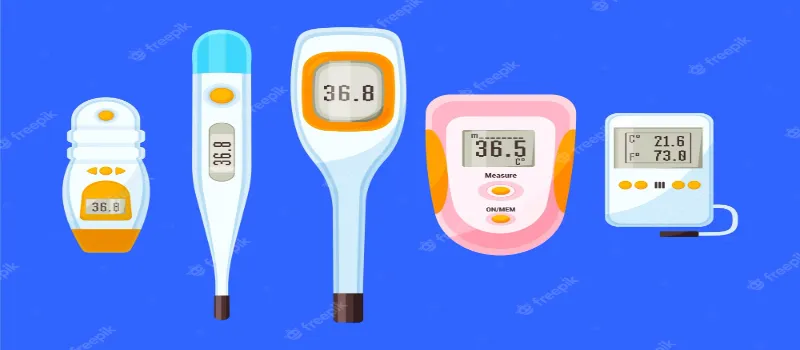A Complete Information on Clinical Thermometer

Posted Date: April 6th, 2023
A clinical thermometer is a type of thermometer used to measure human body temperature. It is typically used in healthcare settings such as hospitals, clinics and doctor’s offices to monitor a patient’s temperature for signs of fever or illness.
A clinical thermometer usually consists of a long, slender, glass or plastic tube with a bulb at one end containing a liquid such as mercury or alcohol. The bulb is placed under the patient’s tongue or armpit and the thermometer is left in place for a few minutes until the temperature stabilizes. The temperature is then read from a scale marked on the thermometer.
See also
What is the used of clinical thermometer?
Clinical thermometers are used to measure a patient’s body temperature which is an important indicator of their health status. Body temperature is the balance between the heat produced by the body and the heat lost to the environment.
A clinical thermometer is used to measure body temperature in various ways, including:
Oral: Placing the thermometer under the tongue to measure the temperature of the mouth.
Rectal: Inserting the thermometer into the rectum to measure the temperature of the body’s core.
Axillary: Placing the thermometer under the arm to measure the temperature of the armpit.
Ear: Inserting the thermometer into the ear canal to measure the temperature of the eardrum.
Clinical thermometers are commonly used in hospitals, clinics and doctor’s offices to monitor the body temperature of patients who are sick or have a fever. They are also used in other settings such as schools and workplaces to screen for fever and potential illness.
Regular monitoring of body temperature using a clinical thermometer can help doctors and healthcare professionals make informed decisions about patient care, including the administration of medication and treatment for infections or illnesses.
Types of thermometers
There are several types of thermometers, each with its own unique characteristics and uses. Some of the most common types of thermometers include:
Mercury Thermometers: These are glass thermometers that use mercury to measure temperature. They are commonly used in medical settings but are being phased out due to concerns about mercury toxicity.
Digital Thermometers: These use electronic sensors to measure temperature and display the results digitally. They are commonly used in medical settings and at home.
Infrared Thermometers: These use infrared radiation to measure temperature without making contact with the object being measured. They are commonly used in industrial settings, as well as for non-contact measurements of body temperature.
Thermocouple Thermometers: These use two different metals to measure temperature based on the voltage generated by the thermocouple. They are commonly used in industrial settings.
Bimetallic Thermometers: These use two different metals that expand at different rates to measure temperature. They are commonly used in mechanical systems and appliances.
Liquid Crystal Thermometers: These use liquid crystals that change color as the temperature changes. They are commonly used for home and educational purposes.
Galileo Thermometers: These use a glass tube filled with a liquid and floating glass spheres of different weights to measure temperature. They are commonly used for decorative purposes.
Each type of thermometer has its own advantages and disadvantages and the choice of which type to use depends on the specific application and requirements.
What is range of clinical thermometer?
The range of a clinical thermometer refers to the minimum and maximum temperatures that it is capable of measuring accurately.
For a clinical thermometer the typical range is between 95 to 110 degrees Fahrenheit (or 35 to 43 degrees Celsius) which is the normal range for human body temperature.
It is important to note that the specific range may vary depending on the type of thermometer and the manufacturer. Some digital thermometers for example may have a wider range and be able to measure temperatures outside of the normal range for human body temperature.
It is also important to follow the instructions provided with the thermometer to ensure that it is used correctly and that the readings are accurate.
Thermometer used in hospital
In hospitals and other healthcare settings, clinical thermometers are typically used to measure the body temperature of patients. Clinical thermometers come in various types including:
Mercury Thermometers: These are glass thermometers that use mercury to measure temperature. While they were commonly used in the past they are being phased out due to concerns about mercury toxicity.
Digital Thermometers: These use electronic sensors to measure temperature and display the results digitally. They are commonly used in medical settings and at home.
Infrared Thermometers: These use infrared radiation to measure temperature without making contact with the object being measured. They are commonly used in industrial settings as well as for non-contact measurements of body temperature.
Digital thermometers are the most commonly used type in hospitals and other healthcare settings because they are fast, accurate and easy to read. They are also easier to clean and sanitize than mercury thermometers which is an important consideration for infection control in a hospital setting.
What are the three main features of a clinical thermometer?
The three main features of a clinical thermometer are:
Sensitivity: Clinical thermometers are designed to be highly sensitive so that they can accurately detect even small changes in body temperature.
Accuracy: Clinical thermometers are designed to provide accurate temperature readings with a minimal margin of error. This is important because even a small difference in temperature can be significant in diagnosing and treating certain illnesses.
Safety: Clinical thermometers are designed to be safe for use on humans and to minimize the risk of injury or infection. This includes features such as break-resistant glass or plastic, non-toxic materials and easy-to-clean surfaces.
Additional features may include easy-to-read displays, memory functions to store previous readings and audible alerts to indicate when the reading is complete.
What are the 20 uses of clinikal thermometer?
A clinical thermometer is a type of thermometer used to measure human body temperature. Here are 20 possible uses of a clinical thermometer:
Measuring body temperature to detect fever or illness
Monitoring body temperature during surgery or medical procedures
Monitoring body temperature during anesthesia to prevent complications
Measuring body temperature during clinical trials or medical studies
Monitoring body temperature in patients with infectious diseases
Monitoring body temperature in patients with neurological conditions
Monitoring body temperature in patients with cardiovascular disease
Monitoring body temperature in patients with respiratory conditions
Monitoring body temperature in patients with endocrine disorders
Monitoring body temperature in patients with renal disease
Monitoring body temperature in patients with cancer or receiving chemotherapy
Monitoring body temperature in patients with autoimmune disorders
Monitoring body temperature in patients with liver disease
Monitoring body temperature in patients with metabolic disorders
Monitoring body temperature in patients with genetic disorders
Monitoring body temperature in neonatal care
Monitoring body temperature in pediatric care
Monitoring body temperature in geriatric care
Screening body temperature in airports and other public places during pandemics or outbreaks
Monitoring body temperature during sports events or other activities to prevent heat stroke.
There are many other possible uses of a clinical thermometer depending on the specific needs and applications in healthcare.
Classification by location
CClinical thermometers can be classified based on the location where they are used to measure body temperature. The three main types of clinical thermometers classified by location are:
Oral Thermometers: These are thermometers designed to be placed under the tongue to measure body temperature. They are typically used in clinical settings or at home and are easy to use and non-invasive. Oral thermometers are a good choice for most patients including adults and children.
Rectal Thermometers: These are thermometers designed to be inserted into the rectum to measure body temperature. They are typically used in clinical settings or at home and are considered the most accurate way to measure body temperature in infants and young children. However rectal thermometers can be uncomfortable for patients and may not be appropriate for all individuals.
Axillary Thermometers: These are thermometers designed to be placed under the arm to measure body temperature. They are typically used in clinical settings or at home and are considered less accurate than oral or rectal thermometers. However axillary thermometers are less invasive and may be more appropriate for certain individuals such as those with oral or rectal conditions or those who are unable to use other types of thermometers.
Classification by technology
Clinical thermometers can also be classified based on the technology used to measure body temperature. The three main types of clinical thermometers classified by technology are:
Mercury Thermometers: These are traditional thermometers that use mercury as the temperature-sensing liquid. They are accurate and reliable but have become less common due to concerns about mercury exposure and environmental impact.
Digital Thermometers: These are thermometers that use electronic sensors to measure body temperature. They are easy to read and provide accurate readings within seconds. Digital thermometers can be used orally, rectally or axillary and are available in various shapes and sizes including disposable and reusable models.
Infrared Thermometers: These are thermometers that use infrared technology to measure body temperature without physical contact. They are typically used to measure temperature from a distance and are particularly useful for screening large numbers of people during pandemics or outbreaks. Infrared thermometers can be used to measure body temperature on the forehead or ear and provide rapid readings without touching the patient. They are not as accurate as other types of thermometers but they are non-invasive and easy to use.
See also
What are the 5 parts of clinical thermometer?
A clinical thermometer typically consists of five parts:
Bulb: This is the part of the thermometer that contains the mercury or other temperature sensing liquid. It is typically made of glass or plastic and is designed to be inserted into the patient’s mouth, rectum or armpit.
Stem: This is the long and narrow part of the thermometer that connects the bulb to the temperature scale. It is usually made of glass or plastic and may be marked with calibration lines to indicate temperature readings.
Temperature Scale: This is the part of the thermometer that displays the temperature readings. It may be marked in Celsius (°C) or Fahrenheit (°F) and may be color coded to indicate normal, high or low temperatur
Graduation marks: These are the lines or numbers on the temperature scale that indicate the temperature readings. They are typically spaced at regular intervals to allow for precise measurement.
Holder: This is the part of the thermometer that allows it to be held securely during use. It may be a plastic or metal casing that surrounds the stem and provides a handle for gripping. Some clinical thermometers also have a flexible or retractable probe for added comfort and ease of use.
Related Posts
Dr. Emily Carter is a seasoned health writer and wellness advocate at Healths News Today. With over a decade of experience in the healthcare industry, she specializes in translating complex medical information into easy-to-understand content that empowers readers to make informed decisions about their health.




